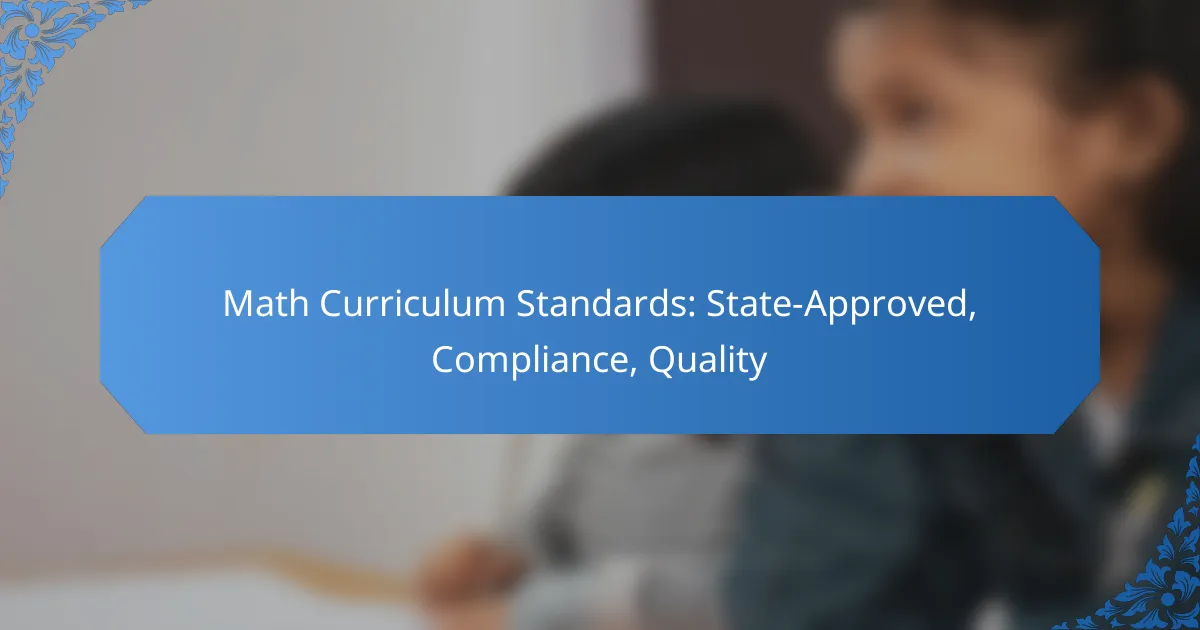State-approved math curriculum standards serve as essential guidelines to guarantee that students receive a consistent and high-quality mathematics education across various states. These standards not only promote uniformity in educational expectations but also ensure compliance with federal and state regulations, guiding the development of curricula that meet specific educational goals. The quality of these standards can significantly impact educational outcomes, making it crucial for them to be research-based and aligned with effective teaching practices.

What Are the State-Approved Math Curriculum Standards?
State-approved math curriculum standards are guidelines established to ensure that students across various states receive a consistent and high-quality mathematics education. These standards outline the knowledge and skills students should acquire at each grade level, promoting uniformity in educational expectations.
Common Core State Standards
The Common Core State Standards (CCSS) provide a clear framework for mathematics education across participating states. They emphasize critical thinking and problem-solving skills, focusing on understanding concepts rather than rote memorization. Schools implementing CCSS typically cover topics such as algebra, geometry, and statistics in a structured manner.
One key feature of the CCSS is its focus on coherence, where concepts are built progressively from one grade to the next. For example, students in early grades learn basic arithmetic, which lays the foundation for more complex algebraic concepts in higher grades.
Texas Essential Knowledge and Skills
The Texas Essential Knowledge and Skills (TEKS) outline the educational standards for mathematics in Texas. These standards are designed to ensure that students gain a comprehensive understanding of mathematical concepts, with an emphasis on real-world applications. TEKS includes specific expectations for each grade level, guiding educators in curriculum development.
TEKS also incorporates a variety of instructional strategies, encouraging hands-on learning and critical analysis. For instance, students might engage in projects that require them to apply mathematical reasoning to solve practical problems, enhancing their engagement and understanding.
California Mathematics Framework
The California Mathematics Framework provides guidance on implementing the state’s mathematics standards, focusing on equity and access to high-quality math education for all students. It emphasizes a balanced approach that includes conceptual understanding, procedural skills, and application of mathematics in real-life contexts.
This framework encourages teachers to create inclusive classrooms where diverse learning needs are met. For example, it suggests using collaborative learning strategies to help students work together and learn from one another, fostering a supportive learning environment.
Florida Standards
The Florida Standards for mathematics establish clear expectations for what students should know and be able to do at each grade level. These standards are designed to prepare students for success in college and careers by emphasizing critical thinking and problem-solving skills.
Florida’s approach includes a focus on mathematical practices, such as reasoning abstractly and quantitatively, which helps students develop a deeper understanding of mathematical concepts. Schools often utilize assessments aligned with these standards to measure student progress and inform instruction.
Next Generation Math Standards
The Next Generation Math Standards aim to provide a modern framework for mathematics education that reflects current research and best practices. These standards emphasize the importance of integrating technology and real-world applications into the learning process.
These standards encourage educators to focus on depth over breadth, allowing students to explore fewer topics in greater detail. For instance, rather than covering a wide array of topics superficially, students might spend more time mastering key concepts, which can lead to a stronger mathematical foundation.

How Do Math Curriculum Standards Ensure Compliance?
Math curriculum standards ensure compliance by providing a structured framework that aligns educational content with federal and state regulations. These standards guide the development of curricula, ensuring that they meet specific educational goals and accountability measures.
Alignment with Federal Guidelines
Alignment with federal guidelines is crucial for ensuring that state-approved math curricula meet national educational objectives. These guidelines often include the Common Core State Standards, which outline key competencies students should achieve at each grade level. States that adopt these standards can receive federal funding and support, making compliance essential.
For example, a state may implement a math curriculum that emphasizes problem-solving and critical thinking skills, aligning with federal expectations. This alignment helps educators focus on essential skills that prepare students for higher education and the workforce.
Assessment and Accountability Measures
Assessment and accountability measures are integral to maintaining compliance with math curriculum standards. States typically require standardized testing to evaluate student performance against established benchmarks. These assessments help identify areas where students excel or need additional support, ensuring that educational goals are met.
Additionally, accountability measures may include regular reviews of school performance and teacher effectiveness. Schools that consistently meet or exceed standards may receive additional funding or resources, while those that fall short may face interventions to improve outcomes.
State Review Processes
State review processes play a vital role in ensuring that math curricula comply with established standards. These processes often involve periodic evaluations of curriculum materials, teaching methods, and student outcomes. States may form committees of educators and experts to assess the effectiveness of the curriculum and recommend necessary adjustments.
For instance, a state might conduct a review every few years to ensure that the math curriculum remains relevant and effective in meeting educational standards. This ongoing evaluation helps maintain high-quality education and ensures that all students receive a robust math education.

What Is the Quality of State Math Curriculum Standards?
The quality of state math curriculum standards varies significantly across the United States, impacting educational outcomes. High-quality standards are research-based, provide clear expectations, and support effective teaching practices.
Research-Based Practices
Research-based practices in math education focus on methods proven to enhance student learning and engagement. These practices often include problem-solving strategies, collaborative learning, and the use of technology to facilitate understanding. States that adopt such practices typically see improved student outcomes.
For example, integrating real-world applications into math lessons can help students grasp abstract concepts. Additionally, aligning curriculum with cognitive development theories ensures that content is age-appropriate and accessible.
Teacher Training and Support
Effective teacher training and ongoing support are crucial for implementing high-quality math curriculum standards. Professional development programs should focus on equipping teachers with the skills to deliver the curriculum effectively and adapt to diverse student needs.
States that provide robust training programs often see higher teacher satisfaction and retention rates. Support can include mentorship, access to resources, and collaborative planning time, which collectively enhance instructional quality.
Student Performance Metrics
Student performance metrics are essential for evaluating the effectiveness of state math curriculum standards. These metrics often include standardized test scores, classroom assessments, and longitudinal studies tracking student progress over time.
By analyzing these metrics, educators can identify areas for improvement and adjust instructional strategies accordingly. States should ensure that performance metrics are transparent and accessible to stakeholders, fostering accountability and continuous improvement in math education.

How to Choose an Online Course Aligned with Math Standards?
To choose an online course aligned with math standards, look for programs that are accredited and explicitly state their compliance with recognized educational standards. Consider factors such as curriculum content, instructor qualifications, and the overall reputation of the institution offering the course.
Accreditation and Approval Status
Accreditation ensures that an online course meets specific educational quality standards. Check if the institution is accredited by a recognized body, such as the Council for Higher Education Accreditation (CHEA) or the U.S. Department of Education. This status often indicates that the course content is reliable and recognized by employers and other educational institutions.
Additionally, verify if the course has state approval, especially if you are in the U.S. Some states require that online courses be approved by local education authorities to ensure they meet state-specific educational standards.
Curriculum Alignment with Standards
Ensure the course curriculum aligns with established math standards, such as the Common Core State Standards (CCSS) or state-specific guidelines. Look for courses that outline how their content meets these standards, as this alignment is crucial for ensuring that students acquire the necessary skills and knowledge.
Review the course syllabus or description to see if it includes key topics and skills outlined in the standards. A well-structured course will typically provide a clear mapping of its content to these standards, which can help you assess its relevance and effectiveness.
Instructor Qualifications
Instructor qualifications are vital for delivering quality education. Check if the instructors hold relevant degrees in mathematics or education and have experience teaching math at various levels. Qualified instructors are more likely to provide effective instruction and support.
Additionally, look for courses that offer information about instructor training and professional development. Instructors who engage in ongoing learning are better equipped to adapt to new teaching methods and educational standards, enhancing the overall learning experience for students.

What Are the Benefits of Following State Math Standards?
Following state math standards provides a structured framework that enhances educational quality and ensures compliance with educational regulations. These standards help educators align their teaching methods and materials with proven practices that benefit student learning outcomes.
Improved Student Outcomes
Adhering to state math standards leads to improved student performance in mathematics. By providing a clear set of expectations, students can develop a solid foundation in key mathematical concepts, which can result in higher test scores and better overall understanding.
For instance, schools that implement these standards often see a significant increase in the percentage of students meeting or exceeding grade-level expectations. This structured approach helps identify areas where students may struggle, allowing for targeted interventions.
Standardized Assessment Readiness
State math standards prepare students for standardized assessments, which are often a requirement for graduation or advancement. These assessments are designed to evaluate students’ mastery of essential math skills, and aligning curriculum with state standards ensures that students are familiar with the types of questions they will encounter.
By focusing on the specific content and skills outlined in the standards, educators can equip students with the knowledge and strategies needed to perform well on these assessments. Regular practice with sample questions and formats can further enhance readiness.
Enhanced Curriculum Consistency
Following state math standards promotes consistency across different classrooms and schools within a state. This uniformity ensures that all students, regardless of their location, receive a comparable education in mathematics.
For example, if a state mandates certain topics to be taught at specific grade levels, teachers can collaborate more effectively, share resources, and develop common assessments. This collaborative approach not only benefits students but also fosters a professional learning community among educators.

How Do Math Curriculum Standards Evolve Over Time?
Math curriculum standards evolve through a combination of educational research, societal needs, and technological advancements. These changes aim to improve student learning outcomes and ensure that the curriculum remains relevant and effective.
Factors Influencing Changes in Math Curriculum Standards
Several factors drive the evolution of math curriculum standards, including advancements in pedagogical research, shifts in workforce demands, and the integration of technology in education. For instance, the rise of data science has prompted a greater emphasis on statistics and probability in many curricula.
Additionally, feedback from educators, parents, and students plays a crucial role in shaping these standards. Regular reviews and updates ensure that the curriculum addresses the needs of diverse learners and reflects current educational best practices.
The Role of State Education Agencies
State education agencies are pivotal in developing and implementing math curriculum standards. They establish guidelines that local school districts must follow, ensuring compliance with federal and state regulations. This oversight helps maintain a baseline quality of education across different regions.
These agencies often collaborate with educators and stakeholders to create standards that are both rigorous and achievable. They may also provide resources and training to help teachers effectively implement the updated standards in their classrooms.
Impact of National and International Standards
National and international standards, such as the Common Core State Standards in the U.S. or the International Baccalaureate framework, influence local math curricula. These frameworks promote consistency and comparability in education, allowing students to transition more smoothly between schools and regions.
Adopting these standards can enhance the quality of math education by incorporating best practices from various educational systems. However, local adaptations may be necessary to meet specific community needs and cultural contexts.
Challenges in Updating Math Curriculum Standards
Updating math curriculum standards can present challenges, including resistance from educators and the need for extensive training. Teachers may be accustomed to existing curricula and may require support to adapt to new standards effectively.
Additionally, ensuring that all stakeholders are on board can be difficult. Engaging parents, community members, and educational professionals in the process can help mitigate resistance and foster a collaborative approach to curriculum development.



